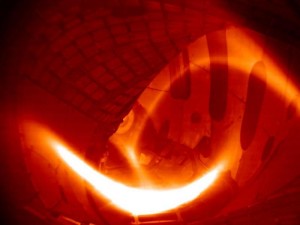The Wendelstein 7-X Fusion Device Produces its First Hydrogen Plasma

Researchers at the Max Planck Institute for Plasma Physics (IPP) have obtained hydrogen plasma at the Wendelstein 7-X fusion device, the world’s largest of the stellarator type. With its first hydrogen plasma production -a necessary step in the nuclear fusion process-, the IPP starts the scientific operation to investigate the suitability of this configuration for use in a power plant.
Stars generate energy by fusion of atomic nuclei. Physicists have conducted nuclear fusion experiments since the 1920s, for harnessing this technology would allow to obtain and unprecedented source of sustainable energy. Currently, the technology is not energetically viable: initiating and maintaining the reaction requires more energy than it is produced from the reaction.
On February 3rd, a 2-MW heat pulse transformed a small volume of hydrogen gas inside the Wendelstein 7-X into hydrogen plasma, a fundamental state of matter with different properties than gas, liquids or solids, and the most abundant form of ordinary matter in the universe. In the reaction, electrons were separated from the hydrogen nuclei; the resultant charged particles floated inside the magnetic chamber generated by the Wendelstein 7-X, without touching the walls. The hydrogen plasma lasted 0.25 seconds and reached 80 million ºC. Several other experiments will be conducted until March. The scientists will then improve the vessel conditions so that it can resist higher heating power and longer discharges. Higher temperatures are needed to make the plasma atoms collide and eventually fuse, releasing vast amounts of energy.
Stellarators as power plants?
When constructing a fusion device, there are two possible designs for the magnetic cage: the tokamak and the stellarator. So far, only the international test reactor ITER (a tomakak) can produce energy-supplying plasma. The Wendelstein 7-X is the largest stellarator-type fusion device in the world, and its creators want to show that stellarators can become power plants. The 7-X will probably the the first stellarator on par with a tokamak. If it finally can sustain 30 minute long pulses, it will have proven a fundamental advantage of stellarators: continuous operation.
Source: IPP

